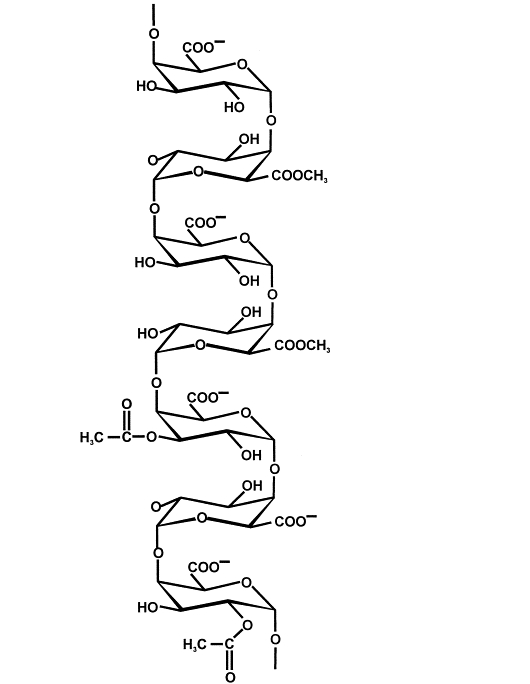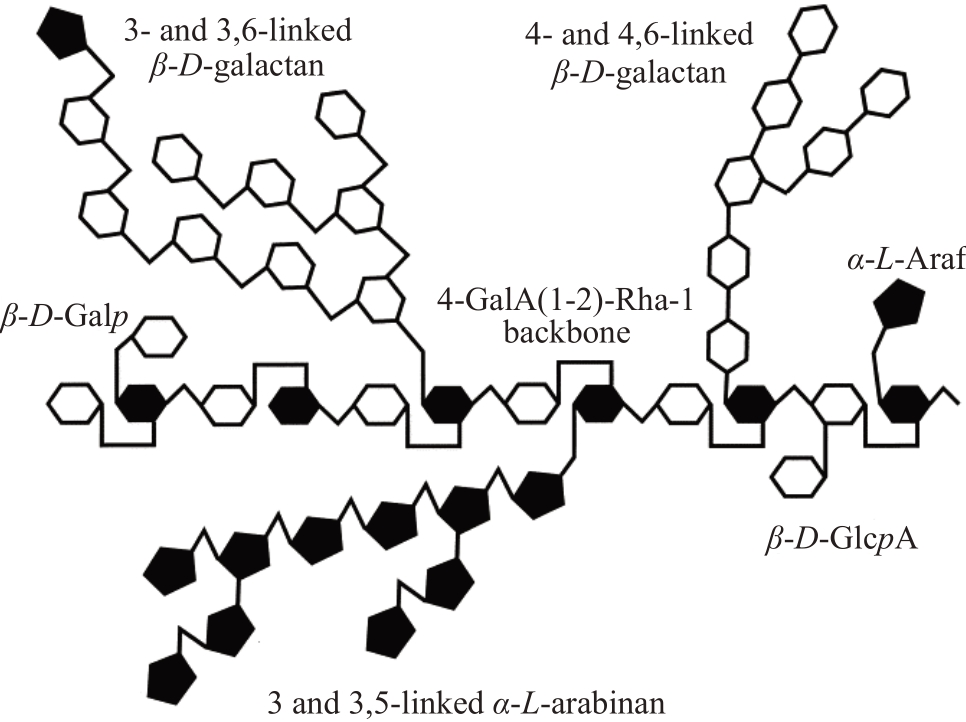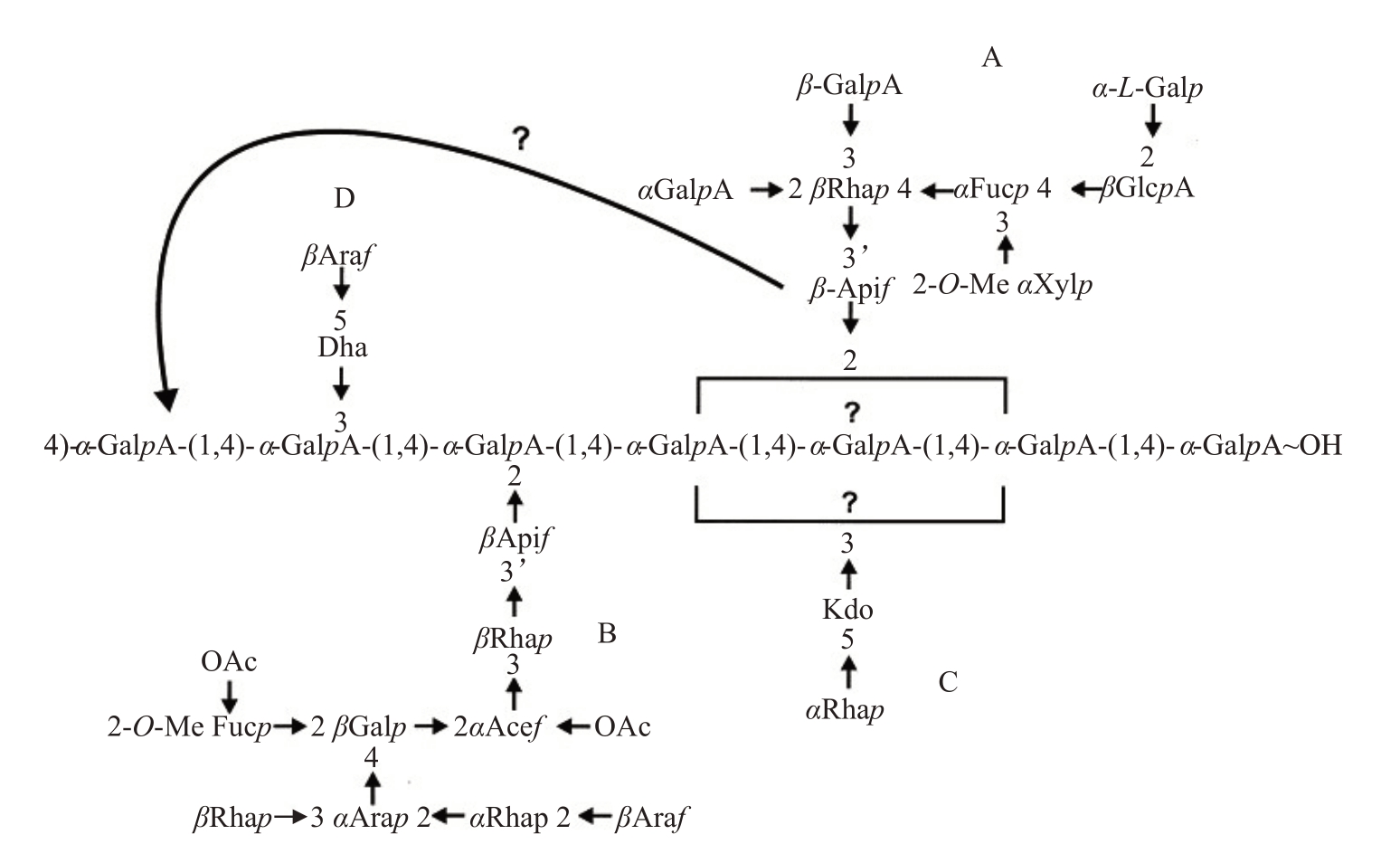水果是人们日常饮食中不可或缺的部分,也是维生素、膳食纤维等营养的重要来源,但是采后水果仍具生命特征,不断成熟衰老,特别是呼吸跃变型果实的自身呼吸作用不断进行,采后果实硬度也随之下降,达到一定临界值后品质发生劣变,影响其品质与商品性。植物细胞壁主要由多糖和蛋白质组成,其中约90%的成分为多糖,而多糖主要包括纤维素、半纤维素和果胶三大类[1]。有研究将植物细胞壁描述为长、薄而坚硬的纤维素微纤维丝群,半纤维素有可能与一部分纤维素微纤维丝结合,果胶填充在各微纤维丝间的空隙中,果胶的存在有助于增强细胞间的黏附和细胞的机械强度[2]。不同植物细胞壁中的果胶含量差异很大,双子叶植物的原代细胞壁中约含有35%的果胶,草类含有2%~10%的果胶,一些水果和蔬菜中果胶的含量则更高[3]。对于不同的植物体细胞,如木质部、韧皮部和厚壁组织等的细胞壁,主要由纤维素、半纤维素和木质素构成,与其他组织相比,含水量更低、刚性更强,果胶含量也更低[4]。
诸多研究表明,呼吸跃变型果实的软化与果胶的降解有着密切的联系,果实软化时细胞壁成分发生去酯化和解聚等修饰作用,变化最大的细胞壁成分是果胶多糖[5],其中有多种果胶修饰酶起到了重要作用[6]。果胶含量与果实硬度密切相关,果实软化时高度甲基化和乙酰化的原果胶降解,形成可溶性果胶和甲基化程度低、酯化度低的果胶酸[7]。研究发现,油柿[8]、杧果[9]等多种植物果实在成熟软化过程中伴随着原果胶含量降低,水溶性果胶和离子可溶性果胶含量上升以及果胶裂解酶、果胶甲酯酶活性增强等过程。模式植物番茄的细胞壁变化已被广泛研究,在成熟时其内果皮的细胞间隙较大、HG钙基细胞黏附水平降低,同时伴随着一系列细胞壁修饰酶的表达和活性变化[10]。
笔者在本文中总结了植物细胞壁中果胶的组成及其分子结构,综述了水果软化过程中果胶的降解规律,同时阐述了果胶酶活性及其相关基因调控机制,以期为今后深入研究果胶降解与果实软化提供参考。
1 果胶的组成与分子结构
果胶是一类以D-半乳糖醛酸为主要成分,通过1,4-糖苷键连接而成的复杂酸性多糖物质[11],主要由大量的半乳糖、阿拉伯糖和鼠李糖组成,具有无毒、成膜能力强、可生物降解等优点,是一种良好的食品生物基包衣基质[12]。由于果胶结构复杂,同时缺乏有效的果胶原位观察技术,针对其结构模型的假说也较多,目前受到广泛认可的是“平滑区和毛发区”模型[13]。
1.1 果胶分子的主要结构域
目前的研究认为果胶分子的结构单元主要包括半乳糖醛酸聚糖(HG)(图1)、鼠李半乳糖醛酸聚糖Ⅰ型(RG-Ⅰ)(图2)、鼠李半乳糖醛酸聚糖Ⅱ型(RG-Ⅱ)(图3)以及木糖半乳糖醛酸聚糖(XGA)(图4)[16]。

图1 HG 结构域的结构简图[14]
Fig.1 Structure diagram of HG domains[14]

图2 RG-Ⅰ结构域的结构简图[14]
Fig.2 Structure diagram of RG-Ⅰdomains[14]

图3 RG-Ⅱ结构域的结构简图[14]
Fig.3 Structure diagram of RG-Ⅱdomains[14]
图中数字代表糖苷键的连接位置。
The number in figure represented the position of the glycosidic bond.

图4 XGA 结构域的结构简图[15]
Fig.4 Structure diagram of XGA domains[15]
HG 是最早被分离出来的结构单元,是由半乳糖醛酸通过α-1,4-糖苷键连接的、无分支侧链的聚合物,大约占果胶总量的65%(图1)[17]。HG 的单糖C-6 可以被甲酯化或酰胺化,C-2 或者C-3 位点也可以被乙酰化[18],而甲基化和乙酰化的位点与修饰程度则主要取决于植物的种类[17]。
RG-Ⅰ是一类具有侧链的结构域,也是果胶结构中最复杂的一类多糖,其主链由[-2-α-Rha-1→4-α-D-GalA-1-]的重复单元所构成(图2)。侧链以阿拉伯糖、半乳糖为主,并且其结构也会随着植物的生长发育而发生改变[19]。
RG-Ⅱ同样是一类复杂的、具有侧链的果胶结构域,总共含有11 种不同的糖残基(图3)。RG-Ⅱ的主链骨架是由1,4-α-D-半乳糖醛酸残基组成的,侧链由1 条八糖链(A)、1 条非糖链(B)以及2 条不同的二糖链(C和D)组成[18]。
XGA 的主链为HG 型结构域(图4),其中部分半乳糖醛酸的O-3位取代有非还原型的木糖或者连接有一条含有2~8 个木糖的支链,木糖支链上大多还连接着阿拉伯糖、半乳糖以及岩藻糖[20]。XGA结构域存在于植物的茎、叶以及生殖器官中,可能与植物的多种功能密切相关[21]。
1.2 “平滑区和毛发区”模型
“平滑区与毛发区”模型(图5[22])可以很好地解释不同植物细胞壁中的果胶结构,因此是目前受到较多认可的一类果胶结构模型。该模型认为果胶结构中具有一条主链,并含单条或多条支链[23]。主链的骨架结构由4 个主要的结构域交替连接而成,分别是半乳糖醛酸聚糖(homogalacturonans,HG)、鼠李半乳糖醛酸聚糖Ⅰ型(rhamnogalacturonan Ⅰ,RG-Ⅰ)、鼠李半乳糖醛酸聚糖Ⅱ型(rhamnogalacturonan Ⅱ,RG-Ⅱ)和木糖半乳糖醛酸聚糖(xylogalacturonan,XGA)[20]。其中,平滑区由无分支的HG 结构域组成,而带有分支侧链的RG-Ⅰ、RG-Ⅱ或XGA在主链上有规律地重复出现,并且大多位于主链末端,组成毛发区[22]。

图5 “平滑区与毛发区”模型示意图[22]
Fig.5 Schematic diagram of smooth and hairy regions model[22]
2 果实软化时果胶成分的变化
果胶在植物的根、茎、叶和果实等器官中均有分布,其主要以原果胶、果胶酸和果胶的形式分布[24]。根据果胶的溶解特性,利用不同的提取溶剂,不同的果胶成分可以被分离得到。利用去离子水、螯合剂和稀碱溶液提取,可以相应得到水溶性果胶(water soluble pectin,WSP)、离子可溶性果胶(ironic soluble pectin,ISP)和共价可溶性果胶(covalent soluble pectin,CSP)[25]。在果实软化过程中,细胞壁的果胶会发生降解,变化主要是果胶酯化程度降低和长链聚合度降低,不溶性的原果胶降解形成可溶性果胶和果胶酸[26],细胞初生壁解体,胞间黏合度降低,分区逐渐消失,最终导致果实软化[27]。研究表明,果实的硬度与细胞壁果胶的成分有着密切关系,其中硬度与WSP含量之间存在着显著的负相关关系,WSP含量较高而CSP含量较低的果实硬度较低,反之则果实的硬度较高[28];Ren等[29]发现番荔枝(跃变型)成熟软化时果胶降解,WSP以及低分子质量的果胶成分迅速增加,果实迅速软化;Song 等[30]报道果实硬度与WSP 含量呈负相关关系,3 种西洋梨Starkrimson、Bartlett 和Abbe Fetel(跃变型)在成熟软化时WSP含量增加。
植物果胶中碱溶性果胶(alkaline soluble pectin,ASP)通常由高分子质量的原果胶和高甲氧基化的不溶性果胶酸组成,草酸溶性果胶(oxalate soluble pectin,OSP)和WSP 通常由低甲氧基化的果胶酸组成。果实成熟时,在果胶酶的作用下,高分子质量、高甲氧基化的果胶被分解为低分子质量、可溶于水的果胶,细胞壁结构被破坏,最终导致果实的软化,以典型的呼吸跃变型果实为例,番茄(跃变型)果实成熟时细胞壁中WSP 含量随着时间的延长逐渐增加,原果胶含量逐渐下降[31];菠萝蜜(跃变型)的原果胶在采后第2 天迅速下降,同时可溶性果胶达到最大值[32]。桑椹(跃变型)细胞壁中含有约10.95%的果胶成分[33],贮藏期间桑椹果实会迅速软化,在4 ℃低温贮藏10 d 以后,大十和白玉王桑椹果实的细胞壁物质含量分别减少为原来的78.4%和80.9%[34]。
近年来,利用细胞壁成分的无标记、可视化技术来获取软化过程中的信息在细胞壁研究领域取得了一定的进展,这是一类可以快速获取大量果实信息的方法。Huang 等[35]采用了共焦拉曼显微镜(CRM)、傅里叶变换红外显微镜(FTIRM)和受激拉曼散射显微术(SRS)3种方法,实现了对水蜜桃(跃变型)在单细胞和大细胞水平上的可视化观测,并研究了果实软化过程中果胶等多种细胞壁成分的变化情况,在细胞层面上为研究果实软化提供更直观的认识。
3 果实软化相关酶活性的变化
果实软化主要原因之一是细胞壁中原果胶降解为可溶性果胶,而这些过程都要依靠特定的果胶酶来催化,目前已经发现的降解果胶的酶类主要有果胶甲酯酶(PME)、多聚半乳糖醛酸酶(PG)、果胶裂解酶(PL)以及β-半乳糖苷酶(β-GAL)[36]。
3.1 果胶甲酯酶(PME)
PME的主要作用是水解果胶中甲酯化的羧基,使糖醛酸残基生成甲醇和聚半乳糖醛酸,进而可以被PG 等作用降解[37]。PME 活性影响着果实的软化过程,Sanchez等[38]发现番木瓜(跃变型)成熟过程中PME活性先显著下降再显著上升,并利用麦克斯韦模型解释了番木瓜质地变化与PME 活性之间的相关性,Dong 等[39]发现在欧洲Comice 梨的WSP 和CSP含量在储存时增加,PME活性先上升后下降,1-MCP处理可以显著降低其酶活性。
在不同呼吸类型果实的软化过程中,PME的贡献程度不完全一致,因此其活性变化也不完全相同。在葡萄果实(非跃变型)中,贮藏期间PME的活性持续上升,60 d 后活性是初始值的5 倍多[40];在番木瓜果实中,PME的活性为峰型变化趋势,贮藏20 d后出现活性高峰[41]。
3.2 多聚半乳糖醛酸酶(PG)
PG是一类细胞结合蛋白,依据作用方式的不同分为内切半乳糖醛酸酶和外切半乳糖醛酸酶,其主要作用是水解去甲酯化的多聚半乳糖醛酸残基的糖苷键,产生半乳糖醛酸,破坏细胞壁的结构,使果实软化。针对大多数呼吸跃变型果实,PG是果实软化的关键酶,其活性在果实成熟软化过程中有显著提高,王倩等[42]研究结果表明,2 种番茄在贮藏第9 天PG活性达到最大(895.72 U·g-1和574.68 U·g-1)。另外还有一部分果实属于例外,比如冬枣(非跃变型),Zhao 等[43]发现贮藏75 d 后冬枣硬度下降了约10%,PG活性从3.4 U·kg-1(第35天)迅速升高至5.6 U·kg-1(第75 天),呈现出延迟但显著的升高趋势;而Tian等[44]则发现半红果中PG活性总体高于白熟果,但在常温下PG酶并没有出现明显的活性高峰,这表明虽然PG参与了果实的软化过程,但并非启动酶,可能是其中的诱导酶;桑椹中PG活性在第Ⅱ快速生长期的早期即达到峰值,在随后的成熟过程中又逐渐降低,说明了PG在桑椹果实软化中未起到关键作用[45]。
3.3 果胶裂解酶(PL)
PL 的作用原理是通过β-反式消除作用降解果胶分子平滑区去甲酯化的HG 的α-1,4-糖苷键,并在非还原性末端生成含不饱和半乳糖醛酸残基的寡聚糖[46]。在果实成熟过程中,PL主要通过降解植物细胞壁中的去甲酯化果胶促进果实的软化[47]。
PL最先在香蕉(跃变型)的成熟过程中被发现,Zhu等[48]发现在香蕉的呼吸跃变早期PL活性开始出现并稳定升高,到第15 天达到峰值,随后逐渐下降。在杧果成熟过程中PL活性显著提高,表现出先上升后下降的趋势,在储存第8天达到峰值,电子束处理可以显著降低PL 活性(约50%)[49],1-甲基环丙烯(1-MCP)也可以抑制PL活性的升高,而外源乙烯可以提高PL活性的峰值(约7%)[50]。番茄贮藏过程中PL活性总体上呈现先上升后下降的趋势,乙烯利可以提高PL活性,促进果实软化,而NO则相反,可以将整个贮藏期间的PL活性抑制在较低的水平,延缓果实的软化[51]。
3.4 β-半乳糖苷酶(β-GAL)
β-GAL属于糖基水解酶35家族,根据其作用方式分成2 类,一类作用于阿拉伯半乳糖上β-半乳糖苷的β-(1,3)和β-(1,6)糖苷键,另一类专一性地作用于果胶支链上的β-(1,4)半乳糖苷键。β-GAL 与细胞壁的加固或者松弛相关[52],主要通过水解果胶中的半乳聚糖影响果实的软化过程。β-GAL活性在果实采后初期就开始升高,比PG和PME更早,同时它和果实硬度之间的相关性远远高于PG 和PME,与细胞壁组分的变化存在显著相关性,这表明β-GAL对果实软化的作用可能大于PG和PME[53]。
不同于其他几种酶活性,β-GAL 活性在果实的未成熟期和成熟早期均相对较高,而随着果实的成熟其活性逐渐下降[49],甜瓜中β-GAL活性在采后1 d便迅速达到峰值,随后逐渐下降[54],湿苞菠萝蜜成熟软化时β-GAL 活性在成熟第Ⅲ阶段达到最高值(0.232 5 U·g-1),到果实完全成熟时又下降到0.110 3 U·g-1[55],这表明β-GAL 主要在软化早期起作用,对软化早期的影响更为明显。
4 果实软化相关酶基因
水果的成熟、软化是受基因调控的酶促和非酶促机制导致细胞壁物质变化的结果。尽管有证据表明,非酶促机制可以促进果胶聚合物的降解,但它们对软化的总体作用仍不清楚[56]。酶促反应造成果胶降解仍然是导致采后果实软化的主要原因。借助分子生物学手段,研究果实软化过程中相关基因的表达和各类果胶酶的活性变化,有助于明晰水果软化背后的分子机制,从而对成熟和软化过程进行干扰和调控,开发水果保鲜技术。表1展示了部分呼吸跃变型果实中果胶酶相关基因在软化时的表达情况。
表1 不同呼吸跃变型果实软化相关基因的表达情况
Table 1 Expression of genes related to fruit softening in different climacteric fruits

4.1 果胶甲酯酶(PME)相关基因
PME相关基因是一个大家族。Zhu等[69]研究发现了桃果实中的71个PME基因,其中36个为类型1(同时编码PME 抑制基因),35 个为类型2(不编码PME抑制基因),类型1的ORF长度在1473~1827 bp之间,预测分子质量在54.16~67.66 ku 之间,类型2的ORF 长度在477~1443 bp 之间,预测分子质量在17.26~49.98 ku之间。
果实成熟软化相关的PME基因,往往在果实采后贮藏的过程中表现出较高的表达量。杏果实在采后低温贮藏期间,PaPME1 基因的表达量持续增加,在35 d 时达到最大值[57];桃果实成熟时有11 个PME 和15 个PMEI 基 因 表 达,其 中1 个PME(Prupe.7G192800)和2 个PMEIs(Prupe.1G114500、Prupe.2G279800)及其启动子是未来研究桃果实成熟生化代谢和调控的潜在靶点[69];Wen 等[58]对番茄PME 家族进行了全基因组分析,总共鉴定得到了57 个PME 基因,并发现了Solyc03g083360、Solyc07g071600 和Solyc12g098340 在成熟时表达量上升,可能与番茄果实的软化相关;同时Gwanpua等[62]还报道了3 个MdPME 基因在苹果中具有显著正相关的关系,表明这3个基因可能是共同调控的。
植物激素乙烯是影响PME 表达的重要因素。苏素香等[70]发现贮运性较好的秦王桃由于缺乏乙烯合成的关键酶而使其在贮藏时乙烯释放量极低,PME的表达量也极低,而贮藏性较差的沙红桃的乙烯释放较多,贮藏时PME 基因的表达也不断增加,导致了其快速软化。
4.2 多聚半乳糖醛酸酶(PG)相关基因
PG 是参与果胶降解过程的一种重要的果胶水解酶,对48个果实PG基因的系统进化分析表明,软化相关基因至少来源于3 个不同基因祖先,其中多数半胱氨酸位点具备一定的保守性,桃的PG 基因已经被定位到第3、4、7、8条染色体上[71]。
PG 在果实成熟软化过程中的重要作用也不断被人们证明,Zhang等[60]发现在梨中PbrPG6参与了果实的软化过程,在成熟软化时其表达量增加,通过沉默果实中的PbrPG6 可以获得更高的硬度;Gwanpua 等[62]发现苹果中的MdPG1 在储存7 d 后表达量增加了数倍,其表达与果实硬度、乙烯产生量之间有着显著的正相关关系(r>0.95),同时指出MdPG1 是苹果中主要的软化相关基因。外源乙烯和1-MCP可以调节果实的成熟过程,研究表明两者主要通过影响PG 相关基因的表达来实现对酶活性的调节,进而影响果实的成熟软化,Qian等[72]发现乙烯处理桃果实后8个PbPG基因的表达显著上调,而1-MCP 的处理则使得相关基因的表达受到显著抑制。
4.3 果胶裂解酶(PL)相关基因
PL 基因在植物中广泛存在,目前已经在番茄、杨树、拟南芥等植物中鉴定发现了多个PL基因。番茄中SLPL 基因参与了果实的成熟软化过程,沉默SLPL基因可以抑制细胞壁降解相关基因的表达,减缓果实的软化速度[73];温波等[63]研究发现桃中PpPL1果实软化阶段显著表达,并且与番茄的SLPL基因属于同一亚族,由此推断PpPL1 可能是桃中参与软化的主要基因,同时发现Pec-Lyase-N结构域可能是实现果胶裂解功能所必需的功能团。
PL基因的表达还受到许多表达因子的影响,SImiR482 是参与番茄软化过程的一类miRNA,莫显兰等[74]研究发现SI-PL13 是SI-miR482 的靶基因,二者的表达存在着此消彼长的关系;Zhang等[65]的研究结果表明,6 个细胞壁代谢相关结构基因AdGAL1、AdMAN1、AdPL1、AdPL5、Adβ-Gal5、AdPME1 和4 个转录因子AdZAT5、AdDOF3、AdNAC083、AdMYBR4为果胶降解的中枢候选基因,同时发现瞬时过表达AdZAT5 可以显著提高AdPL5 和Adβ-Gal5 的表达量,证实了转录因子对PL基因的调控作用。
4.4 β-半乳糖苷酶(β-GAL)相关基因
β-GAL 基因与PG、PME 基因来自于同一个家族,许多学者对其基因结构展开了大量的研究,Zhuang等[75]从香蕉中克隆得到的一段β-GAL cDNA片段显示该基因全长为927 bp,编码一条含有309个氨基酸的多肽链,与植物中的β-GAL 高度同源;Guo 等[76]鉴定得到了桃中的17 个PpBGAL 基因,长度在2154~2691 bp之间,编码的氨基酸数量在717~896个之间。
β-GAL很可能是果实软化过程中酶诱导细胞壁分解的关键调节因子,Gwanpua 等[62]报道苹果中的Mdβ-GAL1、Mdβ-GAL2 在软化时表现出高度表达,甚至高于PG 基因;Yang 等[68]发现Mdβ-GAL1、Mdβ-GAL2、Mdβ-GAL3、Mdβ-GAL5和Mdβ-GAL11的表达水平在苹果果实发育过程中逐渐升高,特别是Mdβ-GAL1、Mdβ-GAL2 和Mdβ-GAL5 被认为与果实成熟过程高度相关。不同的β-GAL 基因有着不同的表达模式,从表3 中可以发现柿的DkGAL1 在果实成熟开始时表达量较高,猕猴桃的AdβGAL-1 在软化末期的表达水平达到峰值。根据先前大量的试验结果,人们将β-GAL基因的表达模式分为4类:①果实成熟时表达水平逐渐提高;②果实发育时有较高的表达水平,而果实成熟时表达水平逐渐降低;③果实中一直维持较高的表达水平;④果实中一直维持较低的表达水平[65]。
综上发现,PME相关基因在果实冷藏期间就有上调,在成熟过程中有较高表达;PG 相关基因主要在成熟时表达,且随着成熟的推进表达水平呈现先上升后下降的趋势,其表达水平的变化与PG 活性的变化情况相一致;PL相关基因主要在果实成熟软化前表达,也有部分基因在成熟末期表现出较高水平的表达;β-GAL 相关基因大多在成熟开始时、果实软化初期表达;同时不同基因间的表达也存在着相关性,某些PG 基因和β-GAL 基因间可能存在着共同调控作用[62]。
5 小结与展望
果实成熟软化是一个复杂、受多种酶催化影响以及多种基因调控的变化过程,不同种类、品种的果实成熟时的果胶降解相关酶及其基因表达也存在差异。特别是呼吸跃变型果实由于其本身呼吸作用的特点而更容易成熟软化,这个过程主要伴随着细胞壁成分尤其是果胶的降解,其中PME、PG、PL 和β-GAL等果胶酶起到了至关重要的作用,在不同的成熟软化阶段,不同的果胶酶基因有着特异性的表达且发挥着不同的作用,果实的成熟软化与这些相关酶基因表达密不可分。同时,这些相关基因的表达与转录调控又受不同激素等信号通路的调控,众多研究也报道了激素类保鲜剂等对果实成熟软化的影响,如乙烯通常可以促进果实的成熟软化,而乙烯作用抑制剂1-MCP 通过延缓果实成熟软化发挥保鲜作用,两者不仅可以影响果胶酶的活性,还可以通过影响相关酶基因的表达水平而起作用。除了内在因素,外部的环境因素如病原体等也会影响果实的成熟软化,很多病原体会释放果胶酶、蛋白酶等细胞外酶,从而引发乙烯、脱落酸等通路,破坏果胶的稳定结构,加速果实的软化。
该领域未来的研究,除了借助前沿生物学研究果胶酶的相关活性与作用机制外,许多非酶类物质,例如羟基自由基,其降解细胞壁多糖引起果胶降解和果实软化的现象也正成为研究的新热点之一。总之,果实采后的细胞壁结构及其果胶等细胞壁成分的变化以及生理调控方式仍是目前对于其机制研究的重点,综合前人的研究推测,PG 是有些果实软化的启动酶,起关键作用,而其他酶可能只起到诱导作用;此外,还有许多果胶降解关键基因被发现报道,这类基因在果实软化中起到更重要的作用,与软化的相关性更高,因此今后可以重点研究此类果实软化过程中启动酶的活性变化及关键基因的表达、转录调控及其相关信号调控通路等。此外,也要关注果实软化是一个多基因调控的过程,除了果胶酶调控基因以外,其他诸如活性氧清除相关基因也会参与果实软化,它们会通过与PG、PL等酶基因的启动子结合而影响软化过程。因此,开发新型保鲜技术时可以考虑开发一些果胶酶的抑制剂或者活性氧清除剂,抑制启动酶的基因表达、降低其酶活性或者抑制活性氧对细胞壁的攻击,从而达到果实保鲜效果。
[1] ULUISIK S,SEYMOUR G B.Pectate lyases:Their role in plants and importance in fruit ripening[J/OL].Food Chemistry,2020,309:125559.DOI:10.1016/j.foodchem.2019.125559.
[2] COSGROVE D J.Diffuse growth of plant cell walls[J].Plant Physiology,2018,176(1):16-27.
[3] FISCHER R L,BENNETT A B.Role of cell wall hydrolases in fruit ripening[J].Annual Review of Plant Physiology and Plant Molecular Biology,1991,42(1):675-703.
[4] IVAKOV A,PERSSON S.Plant cell walls[M].New Jersey:John Wiley&Sons,Ltd,2012.
[5] SINGH Z,SINGH R K,SANE V A,NATH P.Mango-postharvest biology and biotechnology[J].Critical Reviews in Plant Sciences,2013,32(4):217-236.
[6] GIOVANNONI J J.Genetic regulation of fruit development and ripening[J].Plant Cell,2004,16(S):170-180.
[7] LIU Y N,WANG Y,YANG B,LI S E,JIANG H,ZHU Y,WANG B.Effect of preharvest acetylsalicylic acid treatments on ripening and softening of harvested muskmelon fruit[J].Scientia Agricultura Sinica,2017,50(10):1862-1872.
[8] 韩卫娟,傅建敏,王丽媛,王艺儒,刁松锋,李华威,孙鹏,索玉静.油柿果实成熟过程中生理指标的变化规律[J].中南林业科技大学学报,2021,41(9):14-21.HAN Weijuan,FU Jianmin,WANG Liyuan,WANG Yiru,DIAO Songfeng,LI Huawei,SUN Peng,SUO Yujing.Research on physiological qualities during fruit ripening of Diospyros oleifera Cheng[J].Journal of Central South University of Forestry&Technology,2021,41(9):14-21.
[9] 张业歆,刘家粮,潘永贵,高兆银,胡美姣,张正科.氯吡苯脲浸泡处理延缓采后杧果成熟和软化的生理机制[J].食品科学,2021,42(19):234-241.ZHANG Yexin,LIU Jialiang,PAN Yonggui,GAO Zhaoyin,HU Meijiao,ZHANG Zhengke.Physiological mechanisms by which forchlorfenuron soaking treatment delays postharvest ripening and softening of mango fruit[J].Food Science,2021,42(19):234-241.
[10] ORDAZ-ORTIZ J J,MARCUS S E,PAUL KNOX J.Cell wall microstructure analysis implicates hemicellulose polysaccharides in cell adhesion in tomato fruit pericarp parenchyma[J].Molecular Plant,2009,2(5):910-921.
[11] MOHNEN D.Pectin structure and biosynthesis[J].Current Opinion in Plant Biology,2008,11(3):266-277.
[12] SUN C,CAO J P,WANG Y,HUANG L X,CHEN J B,WU J,ZHANG H,CHEN Y Y,SONG C D.Preparation and characterization of pectin-based edible coating agent encapsulating carvacrol/HPβCD inclusion complex for inhibiting fungi[J/OL].Food Hydrocolloids,2022,125(107374):1-11.https://doi.org/10.1016/j.foodhyd.2021.107374.
[13] WANG D D,YEATS T H,ULUISIK S,ROSE J KC,SEYMOUR G B.Fruit softening:Revisiting the role of pectin[J].Trends in Plant Science,2018,23(4):302-310.
[14] RIDLEY B L,O’NEILL M A,MOHNEN D A.Pectins:Structure,biosynthesis,and oligogalacturonide-related signaling[J].Phytochemistry,2011,57(6):929-967.
[15] GOFF A L,RENARD C,BONNIN E,THIBAULT J F.Extraction,purification and chemical characterisation of xylogalacturonans from pea hulls[J].Carbohydrate Polymers,2001,45(4):325-334.
[16] PELLOUX J,RUSTERUCCI C,MELLEROWICZ E J.New insights into pectin methylesterase structure and function[J].Trends in Plant Science,2007,12(6):267-277.
[17] WILLATS W G T,MCCARTNEY L,MACKIE W,KNOX J P.Pectin:Cell biology and prospects for functional analysis[J].Plant Molecular Biology,2001,47(1/2):9-27.
[18] 张春蓬.磷酸氢二钠法制备甘薯果胶工艺及其凝胶特性研究[D].北京:中国农业科学院,2011.ZHANG Chunpeng.Study on sweet potato pectin’s preparation by extracts of disodium hydrogen phosphate solution and its gelling characteristics[D].Beijing:Chinese Academy of Agricultural Sciences,2011.
[19] 李健军.柑橘果胶多糖可控性降解和寡糖片段的分离分析及其活性研究[D].西安:西北大学,2011.LI Jianjun.The study on the controlled degradation of citrus pectic polysaccharide and the purification and activity of oligogalacturonic acid fragments[D].Xi’an:Northwest University,2011.
[20] 吴迪.七种植物中果胶结构域的制备及其分析[D].长春:东北师范大学,2011.WU Di.Preparation and structure analysis of pectin domain from 7 species of plants[D].Changchun:Northeast Normal University,2011.
[21] ENK R,EHEHALT R,GRAHAM J E,BIERHAUS A,REMPPIS A,GRETEN H J.Differential effect of Rhizoma coptidis and its main alkaloid compound berberine on TNF-α induced NFκB translocation in human keratinocytes[J].Journal of Ethnopharmacology,2007,109(1):170-175.
[22] 易建勇,毕金峰,刘璇,吕健,周沫,吴昕烨,赵圆圆,杜茜茜.果胶结构域精细结构研究进展[J].食品科学,2020,41(7):292-299.YI Jianyong,BI Jinfeng,LIU Xuan,LÜ Jian,ZHOU Mo,Wu Xinye,ZHAO Yuanyuan,DU Qianqian.A review:Domain fine structure of pectic polysaccharides[J].Food Science,2020,41(7):292-299.
[23] 张学杰,郭科,苏艳玲.果胶研究新进展[J].中国食品学报,2010,10(1):167-174.ZHANG Xuejue,GUO Ke,SU Yanling.A review on the recent advance in pectin research[J].Journal of Chinese Institute of Food Science and Technology,2010,10(1):167-174.
[24] WOLF S,MOUILLE G,PELLOUX J.Homogalacturonan methyl- esterification and plant development[J].Molecular Plant,2009,2(5):851-860.
[25] SU D L,LI P J,QUEK S Y,HUANG Z Q,YUAN Y J,LI G Y,SHAN Y.Efficient extraction and characterization of pectin from orange peel by a combined surfactant and microwave assisted process[J].Food Chemistry,2019,286:1-7.
[26] 吴宝婷,王娟,邱雪,朱韵昇,张海红.灵武长枣成熟过程中硬度变化的生物力学研究[J].河南农业大学学报,2020,54(5):770-777.WU Baoting,WANG Juan,QIU Xue,ZHU Yunsheng,ZHANG Haihong.Biomechanical study on hardness changes during maturation of Lingwu long jujube[J].Journal of Henan Agricultural University,2020,54(5):770-777.
[27] JARVIS M C,BRIGGS S P H,KNOX J P.Intercellular adhesion and cell separation in plants[J].Plant Cell and Environment,2003,26(7):977-989.
[28] DENG L Z,PAN Z L,ZHANG Q,LIU Z L,ZHANG Y,MENG J S,GAO Z J,XIAO H W.Effects of ripening stage on physicochemical properties,drying kinetics,pectin polysaccharides contents and nanostructure of apricots[J/OL].Carbohydrate Polymers,2019,222:114980.DOI:10.1016/j.carbpol.2019.114980.
[29] REN Y Y,SUN P P,WANG X X,ZHU Z Y.Degradation of cell wall polysaccharides and change of related enzyme activities with fruit softening in Annona squamosa during storage[J/OL].Postharvest Biology and Technology,2020,166(3):111203.https://doi.org/10.1016/j.postharvbio.2020.111203.
[30] SONG L Y,WANG Z G,WANG Z M,MENG G,ZHAI R,CAI M,MA F W,XU L F.Screening of cell wall-related genes that are expressed differentially during ripening of pears with different softening characteristics[J].Postharvest Biology and Technology,2016,115:1-8.
[31] WEI Y Y,ZHOU D D,WANG Z J,TU S C,SHAO X F,PENG J,PAN L Q,TU K.Hot air treatment reduces postharvest decay and delays softening of cherry tomato by regulating gene expression and activities of cell wall-degrading enzymes[J].Journal of the Science of Food and Agriculture,2018,98(6):2105-2112.
[32] 王俊宁,吕庆芳,丰锋,谢江辉,魏长斌,李映晖,叶春海.湿包类型菠萝蜜采后呼吸跃变和主要成分的变化[J].园艺学报,2014,41(2):329-334.WANG Junning,LÜ Qingfang,FENG Feng,XIE Jianghui,WEI Changbin,LI Yinghui,YE Chunhai.Changes in respiration,ethylene and biochemical values of soft jackfruits during the ripening period[J].Acta Horticulturae Sinica,2014,41(2):329-334.
[33] KHODAIYAN F,PARASTOUEI K.Co-optimization of pectin and polyphenols extraction from black mulberry pomace using an eco-friendly technique:Simultaneous recovery and characterization of products[J].International Journal of Biological Macromolecules,2020,164:1025-1036.
[34] 姜建中,蔡冲,崔旭红,翁连娟,李若南.桑椹采后自溶过程中的质地与细胞壁结构变化[J].蚕业科学,2018,44(4):580-587.JIANG Jianzhong,CAI Chong,CUI Xuhong,WENG Lianjuan,LI Ruonan.Changes in texture and cell wall structure of postharvest mulberry fruits during aril breakdown[J].Acta Sericologica Sinica,2018,44(4):580-587.
[35] HUANG W N,NIE Y T,ZHU N,YANG Y F,ZHU C Q,JI M B,WU D,CHEN K S.Hybrid label-free molecular microscopies for simultaneous visualization of changes in cell wall polysaccharides of peach at single- and multiple-cell levels during postharvest storage[J/OL].Cells,2020,9(3):761.DOI:10.3390/cells9030761.
[36] 佟兆国,王飞,高志红,周军,徐秋红,章镇.果胶降解相关酶与果实成熟软化[J].果树学报,2011,28(2):305-312.TONG Zhaoguo,WANG Fei,GAO Zhihong,ZHOU Jun,XU Qiuhong,ZHANG Zhen.Advances in research on the relationship between pectolytic enzymes and fruit softening[J].Journal of Fruit Science,2011,28(2):305-312.
[37] MOUSTACAS A,NARI J,BOREL M,NOAT G,RICARD J.Pectin methylesterase,metal ions and plant cell wall extension:The role of metal ions in plant cell-wall extension[J].Biochemical Journal,1991,279(2):351-354.
[38] SANCHEZ N,GUTIERREZ-LOPEZ G F,CAEZ-RAMIREZ G.Correlation among PME activity,viscoelastic,and structural parameters for Carica papaya edible tissue along ripening[J].Journal of Food Science,2020,85(2):1805-1814.
[39] DONG Y,ZHANG S Y,WANG Y.Compositional changes in cell wall polyuronides and enzyme activities associated with melting/mealy textural property during ripening following longterm storage of‘Comice’and‘d'Anjou’pears[J].Postharvest Biology&Technology,2018,135:131-140.
[40] 张玉丽,郭芹,彭新媛,王吉德,吴忠红,潘俨,吴斌.双组分SO2-ClO2 保鲜剂对红提葡萄采后软化相关酶的影响[J].食品工业科技,2014,35(6):307-312.ZHANG Yuli,GUO Qin,PENG Xinyuan,WANG Jide,WU Zhonghong,PAN Yan,WU Bin.Bi-component SO2-ClO2 preservative to softening related enzymes of Red Globe grape[J].Science and Technology of Food Industry,2014,35(6):307-312.
[41] 李文文,黄铭慧,邢浩,张鲁斌,李雯.1-MCP 处理对采后番木瓜果实软化相关酶活性的影响[J].食品科技,2014,39(9):51-55.LI Wenwen,HUANG Minghui,XING Hao,ZHANG Lubin,LI Wen.Effects of 1-MCP on enzyme activities related to cell wall hydrolysis in harvested papaya fruits[J].Food Science and Technology,2014,39(9):51-55.
[42] 王倩,郏艳红,孙海波,吉立柱.不同耐贮性粉果番茄贮藏期间果实软化相关酶活性的研究[J].保鲜与加工,2020,20(1):72-77.WANG Qian,JIA Yanhong,SUN Haibo,JI Lizhu.Research on the activities of enzymes involved in fruits softening of pink tomato with different storage property during storage[J].Storage and Process,2020,20(1):72-77.
[43] ZHAO Y T,ZHU X,HOU Y Y,WANG X Y,LI X H.Effects of nitric oxide fumigation treatment on retarding cell wall degradation and delaying softening of winter jujube (Ziziphus jujuba Mill.cv.Dongzao)fruit during storage[J/OL].Postharvest Biology and Technology,2019,156:110954.DOI:10.1016/j.postharvbio.2019.110954.
[44] TIAN S L,ZHAO H Q,XUE X M,ZHAO Z H,ZHOU J Y.Effects of LOX and PG enzymes in Chinese jujube fruit (Zizyphus jujuba Mill.cv.Dongzao) on its softening and senescence[J].Food Science,2008,29(5):446-448.
[45] 赵晓晓.桑椹果实内源激素变化及其与果实发育成熟关系的研究[D].杨凌:西北农林科技大学,2019.ZHAO Xiaoxiao.Study on the changes of endogenous hormones in mulberry fruit and its relationship with fruit development and maturity[D].Yangling:Northwest A&F University,2019.
[46] YADAV S,YADAV P K,YADAV D,YADAV K D S.Pectin lyase:A review[J].Process Biochemistry,2009,44(1):1-10.
[47] 陈乐天,王慧婷,韩靖鸾,栾莹.植物果胶裂解酶的研究现状及展望[J].华南农业大学学报,2019,40(5):71-77.CHEN Letian,WANG Huiting,HAN Jingluan,LUAN Ying.Research progress and perspective of plant pectin lysase[J].Journal of South China Agricultural University,2019,40(5):71-77.
[48] ZHU X Y,SHEN L,FU D W,SI Z W,WU B,CHEN W X,LI X P.Effects of the combination treatment of 1-MCP and ethylene on the ripening of harvested banana fruit[J].Postharvest Biology&Technology,2015,107:23-32.
[49] NGUYEN T T,KATO M,MA G,ZHANG L C,UTHAIRATANAKIJ A,SRILAONG V,LAOHAKUNJIT N,JITATRRRAT P.Electron beam radiation delayed the disassembly of cell wall polysaccharides in harvested mangoes[J/OL].Postharvest Biology and Technology,2021,178:111544.DOI:10.1016/j.postharvbio.2021.111544.
[50] CHOURASIA A,SANE V A,NATH P.Differential expression of pectate lyase during ethylene-induced postharvest softening of mango (Mangifera indica var.Dashehari) [J].Physiologia Plantarum,2006,128(3):546-555.
[51] 李艳娇,朱璇,敬媛媛,周江,吴斌.NO 与乙烯利处理对番茄果实采后软化相关酶活的影响[J].食品科技,2016,41(7):32-37.LI Yanjiao,ZHU Xuan,JING Yuanyuan,ZHOU Jiang,WU Bin.Effects of the combination treatment of nitric oxide and ethephon on softening related enzyme activity of harvested tomato fruits[J].Food Science and Technology,2016,41(7):32-37.
[52] 魏建梅,马锋旺.苹果果实β-Gal 和LOX 活性变化特性及其与果实软化的关系[J].园艺学报,2009,36(5):631-638.WEI Jianmei,MA Fengwang.The characteristics of B-Gal and LOX activities in apple(Malus domestica Borkh.)fruit and their relation to fruit softening[J].Acta Horticulturae Sinica,2009,36(5):631-638.
[53] 魏建梅,马锋旺,关军锋,袁军伟,朱向秋.京白梨果实后熟软化过程中细胞壁代谢及其调控[J].中国农业科学,2009,42(8):2987-2996.WEI Jianmei,MA Fengwang,GUAN Junfeng,YUAN Junwei,ZHU Xiangqiu.Cell wall metabolism and its regulation in harvested Pyrus ussuriensis Maxin.cv.Jingbaili fruit during ripening[J].Scientia Agricultura Sinica,2009,42(8):2987-2996.
[54] 张敏,王爱玲,杨军,杜娟,廖新福.甜瓜‘黄醉仙’果实采后软化过程中细胞壁水解酶的变化[J].西北农林科技大学学报(自然科学版),2015,43(4):113-117.ZHANG Min,WANG Ailing,YANG Jun,DU Juan,LIAO Xinfu.Changes of cell wall degrading enzymes during post-harvest softening of melon‘Huangzuixian’[J].Journal of Northwest A&F University(Natural Science Edition),2015,43(4):113-117.
[55] 董黎梨,汪永保,李映志,李洪波,张佳琦,叶春海.菠萝蜜果实糖苷酶和多聚半乳糖醛酸酶的活性变化[J].南方农业学报,2013,44(6):924-929.DONG Lili,WANG Yongbao,LI Yingzhi,LI Hongbo,ZHANG Jiaqi,YE Chunhai.Activity of glycosidase and polygalacturonase in jackfruit fruit[J].Journal of Southern Agriculture,2013,44(6):924-929.
[56] JIN C H,KAN J,WANG Z J,LU Z X,YU Z F.Activities of βgalactosidase and α-L-arabinofuranosidase,ethylene biosynthetic enzymes during peach ripening and softening[J].Journal of Food Processing and Preservation,2006,30(5):515-526.
[57] HOU Y Y,WU F,ZHAO Y T,SHI L,ZHU X.Cloning and expression analysis of polygalacturonase and pectin methylesterase genes during softening in apricot(Prunus armeniaca L.)fruit[J].Scientia Horticulturae,2019,256:108607.
[58] WEN B,ZHANG F,WU X Z,LI H.Characterization of the tomato(Solanum lycopersicum)pectin methylesterases:Evolution,activity of isoforms and expression during fruit ripening[J/OL].Frontiers in Plant Science,2020,11:238.DOI:10.3389/fpls.2020.00238
[59] LI Y L,HE H,HOU Y Y,KELIMU A,WU F,ZHAO Y T,SHI L,ZHU X.Salicylic acid treatment delays apricot(Prunus armeniaca L.) fruit softening by inhibiting ethylene biosynthesis and cell wall degradation[J/OL].Social Science Electronic Publishing,2022,300:111061.DOI:10.2139/ssrn.4017119.
[60] ZHANG S L,MA M,ZHANG H P,ZHANG S L,QIAN M,ZHANG Z,LUO W Q,FAN J B,LIU Z Q,WANG L B.Genome-wide analysis of polygalacturonase gene family from pear genome and identification of the member involved in pear softening[J/OL].BMC Plant Biology,2019,19(1):587.DOI:10.1186/s12870-019-2168-1.
[61] HUANG W J,CHEN M Y,ZHAO T T,HAN F,ZHANG Q,LIU X L,JIANG C Y,ZHONG C H.Genome-wide identification and expression analysis of polygalacturonase gene family in kiwifruit (Actinidia chinensis) during fruit softening[J/OL].Plants,2020,9(3):327.DOI:10.3390/plants9030327.
[62] GWANPUA S G,MELLIDOU I,BOECKX J,KYOMUGASHO C,BESSEMANS N,VERLINDEN B E,HERTOG M,HENDRICKX M,NICOLAI B M,GEERAERD A H.Expression analysis of candidate cell wall-related genes associated with changes in pectin biochemistry during postharvest apple softening[J].Postharvest Biology and Technology,2016,112:176-185.
[63] 温波,王亚兰,何丽丽,张峰,YAOWAPA Boon-Ek,柳士勇.桃果胶裂解酶编码基因PpPL1 的鉴定及其在果实成熟软化过程中的表达[J].核农学报,2020,34(8):1681-1689.WEN Bo,WANG Yalan,HE Lili,ZHANG Feng,YAOWAPA Boon-Ek,LIU Shiyong.ldentification of peach pectate lyase coding gene PpPL1 and its expression during fruit ripening and softening[J].Journal of Nuclear Agricultural Sciences,2020,34(8):1681-1689.
[64] 王柳凤,樊连梅,刘更森,姜雪娇,原永兵.乌桃果胶裂解酶基因(PpPL)的克隆及其在花色苷降解中的作用[J].分子植物育种,2017,15(8):3046-3056.WANG Liufeng,FAN Lianmei,LIU Gengsen,JIANG Xuejiao,YUAN Yongbing.Cloning of pectate lyase (PpPL) identified from‘Wutao’and its role in anthocyanins degradation[J].Molecular Plant Breeding,2017,15(8):3046-3056.
[65] ZHANG Q Y,GE J,LIU X C,WANG W Q,LIU X F,YIN X R.Consensus co-expression network analysis identifies AdZAT5 regulating pectin degradation in ripening kiwifruit[J].Journal of Advanced Research,2021,DOI:10.1016/j.jare.2021.11.019.
[66] 班秋妍.柿果实成熟软化中β-半乳糖苷酶基因功能分析[D].杨凌:西北农林科技大学,2018.BAN Qiuyan.Identification and functional characterization of βgalactosidase genes in persimmon fruit ripening[D].Yangling:Northwest A&F University,2018.
[67] 冯新,赖瑞联,高敏霞,陈文光,吴如健,陈义挺.Adβgal-1 和Adβgal-2 克隆及其在猕猴桃果实软化中的作用[J].中国农业科学,2019,52(2):312-326.FENG Xin,LAI Ruilian,GAO Minxia,CHEN Wenguang,WU Rujian,CHEN Yiting.Cloning of Adβgal-1 and Adβgal-2 genes and their roles during fruit softening of kiwifruit[J].Scientia Agricultura Sinica,2019,52(2):312-326.
[68] YANG H J,LIU J L,DANG M L,ZHANG B,LI H G,MENG R,QU D,YANG Y Z,ZHAO Z Y.Analysis of β-galactosidase during fruit development and ripening in two different texture types of apple cultivars[J/OL].Frontiers in Plant Science,2018,9:539.DOI:10.3389/fpls.2018.00539.
[69] ZHU Y Q,ZENG W F,WANG X B,PAN L,NIU L,LU Z H,CUI G C,WANG Z Q.Characterization and transcript profiling of PME and PMEI gene families during peach fruit maturation[J].Journal of the American Society for Horticultural Science,2017,142(4):246-259.
[70] 苏素香,赵彩平,曹丽军,李金金,李芳,韩明玉.两种不同耐贮性桃果实采后乙烯合成和果实软化相关基因表达的差异[J].农业生物技术学报,2015,23(4):450-458.SU Suxiang,ZHAO Caiping,CAO Lijun,LI Jinjin,LI Fang,HAN Mingyu.The difference of ethylene biosynthesis and expression of softening related genes between two peach (Prunus persica)cultivars with different storage property after harvest[J].Journal of Agricultural Biotechnology,2015,23(4):450-458.
[71] 魏潇,刘威生,刘宁,章秋平,张玉萍,刘硕,刘有春.果实软化相关PG 基因的进化分析和基因组定位[J].园艺学报,2011,38(9):1791-1799.WEI Xiao,LIU Weisheng,LIU Ning,ZHANG Qiuping,ZHANG Yuping,LIU Shuo,LIU Youchun.Phylogenetic analysis and genomic localization of polygalacturonase genes related to fruit softening[J].Acta Horticulturae Sinica,2011,38(9):1791-1799.
[72] QIAN M,ZHANG Y K,YAN X Y,HAN M Y,LI J J,LI F,LI F R,ZHANG D,ZHAO C P.Identification and expression analysis of polygalacturonase family members during peach fruit softening[J].International Journal of Molecular Sciences,2016,17(11):1933.
[73] 唐培培.SlRCHY1 和SlPL 在番茄果实发育及成熟过程中的功能研究[D].郑州:郑州大学,2019.TANG Peipei.Functional studies of SIRCHY1 and SIPL in theregulation of tomato fruit development and ripening[D].Zhengzhou:Zhengzhou University,2019.
[74] 莫显兰,史列琴,陆秋利,王小敏,任振新.Sl-miR482 在番茄果实中的表达分析及STTM 沉默载体的构建[J].生物技术通报,2019,35(12):50-56.MO Xianlan,SHI Lieqin,LU Qiuli,WANG Xiaomin,REN Zhenxin.Expression analysis of Sl-miR482 in tomato fruit and the construction of STTM silencing vector[J].Biotechnology Bulletin,2019,35(12):50-56.
[75] ZHUANG J P,SU J,LI X P,CHEN W X.Cloning and expression analysis of β-galactosidase gene related to softening of banana(Musa sp.)fruit[J].Journal of Plant Physiology and Molecular Biology,2006,32(4):411-419.
[76] GUO S L,SONG J,ZHANG B B,HANG J,MA R J,YU M L.Genome-wide identification and expression analysis of beta-galactosidase family members during fruit softening of peach[Prunus persica (L.) Batsch][J].Postharvest Biology and Technology,2018,136:111-123.